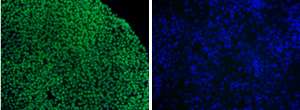Stem cells: Keeping differentiation in check

Researchers at the A*STAR Institute of Medical Biology (IMB) have discovered a critical checkpoint protein that controls when human embryonic stem cells (hESCs) begin to differentiate.
The Nodal/Activin signaling pathway is an important regulator of hESC fate. Signaling molecules in this pathway trigger the downstream proteins SMAD2 and SMAD3 to activate a transcription factor known as NANOG, as well as other core pluripotency proteins. These regulatory factors, in turn, ensure that the self-renewing hESCs remain capable of forming all cell types in the embryo and avoid differentiation. When differentiation is triggered, however, the role of this signaling axis changes, and the very same pathway begins to drive the formation of primitive cell types, namely the mesoderm and endoderm.
To explain these contrasting effects of Nodal/Activin signaling, a team led by the IMB's Ray Dunn explored the role of repressor proteins in the pathway. "We reasoned that one explanation for why hESCs do not differentiate in the presence of Nodal/Activin is the existence of repressor proteins that decorate the regulatory elements of differentiation genes and turn them off," Dunn explains. "In my lab, we identified one such repressor that fits this bill, [it is] called SNON."
SNON, an abbreviation of Ski-related oncogene N, is a potent repressor of SMAD2 and SMAD3 and, as Dunn's team showed, is abundant in undifferentiated hESCs, but only at the promoters of differentiation genes. At the onset of differentiation, SNON is destroyed by the proteasome, the cell's clean-up machinery for unwanted proteins. SNON levels then drop precipitously (see image), which allows SMAD2 and SMAD3 to cooperate with other transcription factors involved in the determination of cell fate, including FoxA2. This leads to the formation of early mesoderm and endoderm, two of the three primitive germ layers.
"Our research shows that when hESCs begin to differentiate, SNON is targeted for degradation," says Dunn. This finding is consistent with many studies of cancer cell lines, which, like hESCs, retain the ability for continuous proliferation and also have elevated levels of SNON.
One outstanding question, according to Dunn, remains the identity of the molecules that target SNON for degradation. A protein called ARKADIA is one suspect. ARKADIA is known to regulate SNON stability in a cell type-dependent fashion, but its role in embryonic stem cells remains unclear. "Follow up experiments in our lab aim to determine whether ARKADIA acts alone or collaborates to degrade SNON in hESCs," says Dunn.
More information: Tsuneyoshi, N., et al. The SMAD2/3 corepressor SNON maintains pluripotency through selective repression of mesendodermal genes in human ES cells. Genes & Development 26, 2471–2476 (2012). genesdev.cshlp.org/content/26/22/2471.abstract
Journal information: Genes & Development















